Untouchable
UNTOUCHABLES
An exhibit dedicated to animals that should not be touched and should also not be feared as they are extremely important to ecosystem dynamics.
Here is some information on frequent species exhibited.
Fire Salamander (Salamandra salamandra)
Behavior: shed old skin and eat it. Overheat easily. Hide. Hunt at night. Use rabbit burrows for homes.
Food: slugs, earthworms, grasshoppers, flies, beetles, spiders, centipedes, millipedes
Habitat: fallen logs, under stones in cool damp region
Life Span: 50+ years
Humans: no major threat to humans, as long as toxin not ingested. When handling wear gloves, toxin may cause minor skin irritation
Predators: fish, reptiles, larger amphibians, birds, small mammals-shrews & opossums
Reproduction: internal fertilization. Gestation 2-5 months. Females return to aquatic area, pond or lake, to give birth. After birth, young stay in larval stage in water for 3-5 months til metamorphosis, then become terrestrial adults
Size: .67 oz.
Threats: habitat change or loss from deforestation and pollution
Venom: in rows on sides of head. Can shoot it. Only in adults. Defense against being eaten and microbial attack. Can withstand fire by coating body in venom
Stone Fish
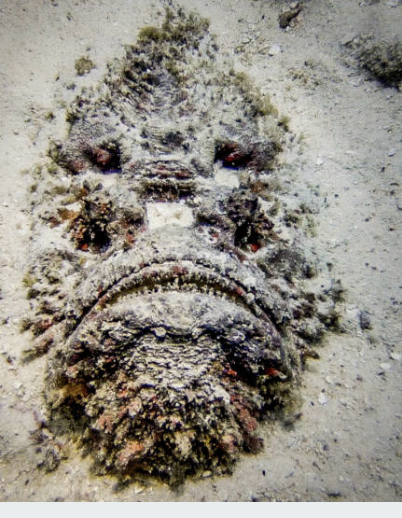
Behavior: world's most venomous fish. Camouflage in surroundings. 13 spines on top w/venom. Venom not used for hunting. Can attack prey in .015 seconds. Spits water. Slow swimmer.
Food: shrimp, fish
Habitat: reef bottoms, near rocks
Humans: venom fatal within 2 hours. Excruciating pain, swelling. Rapidly causes paralysis, tissue necrosis, even heart failure.
Life Span: 5-10 years in wild
Predators: bottom feeding sharks, rays
Range: Indo-Pacific, North Australia
Reproduction: 1 million eggs. Males release sperm on top. Most eggs eaten
Size: 5 lbs. 14-20"
Status: non-threatened
Cone Snail
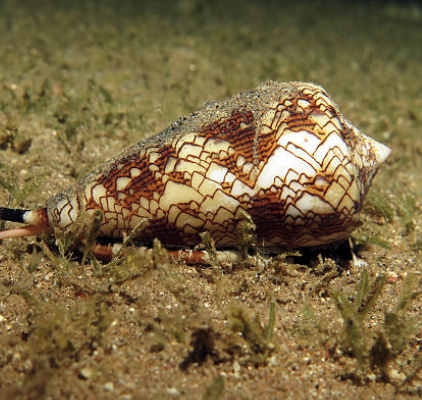

Behavior: active at night, rely on smell to hunt
1) Proboscis - hunting tool. Venom injected into prey w/harpoon loaded into long thin tube
2) Siphon - similar to a nose, long extendable tube detects prey, directs water to gills to help w/respiration
3) Eye stalks - 2 eyes, either side of mouth. Don't know how well can see, or if enough light in some deeper habitats to make it worthwile
4) Mouth - huge extendable mouth. Extends outwards to engulf prey. Muscle contracts to bring mouth back into shell.
5) Foot - long and muscular, extends to move along surfaces
Habitat: Indian, Pacific, Caribbean & Red Sea, Southern California, Florida, shallow reefs partially buried under sandy sediments, rocks or corals. Bury under sand to hide from prey/predators
Humans: not necessarily fatal, but depending on species, amount of venom injected & victim's size and susceptibility, complete paralysis may occur, which may lead to death. Neurotoxins used to make medicine to treat neuropathic pain.
Life Span: 10-20 years wild and captive
Predators: few. Hermit & horseshoe crabs
Reproduction: eggs fertilized internally by male sperm. Egg capsules contain 500-700 eggs each. Capsules laid under rocks, very few survive. Eggs that survive hatch about 16-17 days. Larvae remain pelagic for about 16 days, then settle onto substrate - about 0.06" long.
Size: ~ 1" - 9"
Status: least concern
Sting: to humans - may not feel pain. Feel numb or stinging.
Fighting Conch (Strombus pugilis)

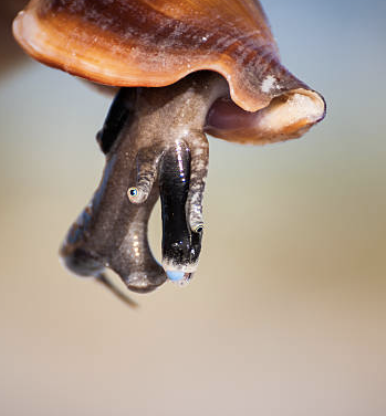
Behavior: Despite the name, this species is neither aggressive nor dangerous. They use their strong foot to forage for food. If turned upside down, the conch can use that foot as a catapult. Fighting conches have well developed eyes, which gives them better vision than many other snails.
Diet: Detritus, algae and bacteria.
Habitat: Intertidal zones. Marine, alkaline and warm waters. Prefer shallow waters, seagrass beds, coral reefs.
Range: Tropical waters along the eastern coasts of the Americas, from Florida to Brazil.
Life Span: Up to 10 years.
Poison: None
Predators: Hermit crabs
Reproduction: Conch snails are dioecious, with the female having an egg channel in the foot. A male must mate with the female and fertilize the eggs before they are laid. If there is more than one male present, the two males may "fight", using their proboscis. A single nest can contain over 180,000 eggs. They are very small and hatch as free swimming larvae, leaving them vulnerable to be eaten. They metamorphose into juvenile snails after 18 to 24 days.
Size:3-4 inches
Food: algae from dead corals
Habitat: deeper water near corals. 0-1300 feet
Life Span: 4-8 years in wild, depending on temperature and food
Poison: in spines. Shattering of spine leaves organic material in wound causing intensely painful infections. Poisonous mucous seems to have very little effect on humans.
Predators: queen triggerfish, Caribbean spiny lobsters, Caribbean helmets, 2 species of toadfish
Range: tropical W. Atlantic, Caribbean, Gulf of Mexico, N & E coasts of South America to Brazil, E. Atlantic at Canary Islands
Reproduction: males and females excrete fluid to alert others to respond by releasing eggs/sperm in mass reproduction. More gametes = higher chance of fertilization. Summer/lunar months
Size: body 3-4"D, spines up to 12"
Coral Catfish (Plotosus lineatus) A.K.A. - Striped Eel Catfish
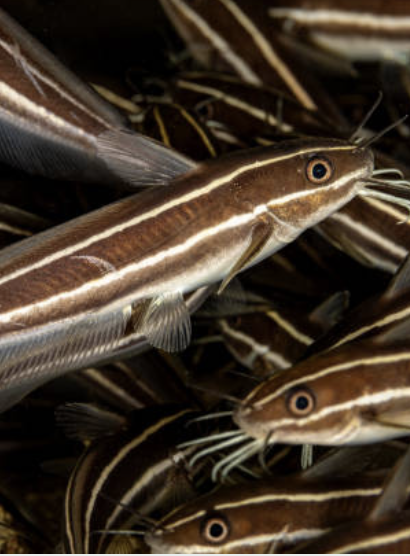
Behavior: Aggressive, hardy scavengers. Best kept in schools.
Diet: Smaller fish and invertebrates, algae, detritus.
Habitat: Coral reefs. Also can be found found in estuaries and tide pools.
Range: Indian Ocean, Western Pacific, East Africa
Venom: Highly venomous spine found in the dorsal and pectoral fins. Can be fatal.
Reproduction: Oviparous, Male digs a nest in demersal area, entices female to lay eggs. Male will guard the eggs.
Size: Up to 12 inches.
Banngai Cardinal Fish (in with long spined sea urchin)
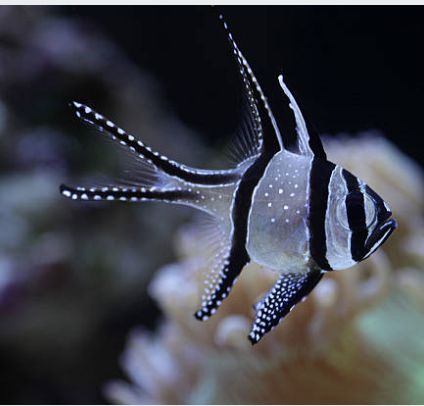
Behavior: semi-aggressive, hide in spine of sea urchins
Food: carnivore, shrimp, bloodworms
Habitat: around jetties, over sandy bottoms w/sea grasses
Life Span: 2 - 4 years
Predators: humans for pet trade
Range: Banngai Archipelago, Indonesia
Reproduction: spawn. male carries in mouth for protection
Size: 3"
Status: Endangered
Threats: Humans
Longhorn Cowfish (Lactoria cornuta)
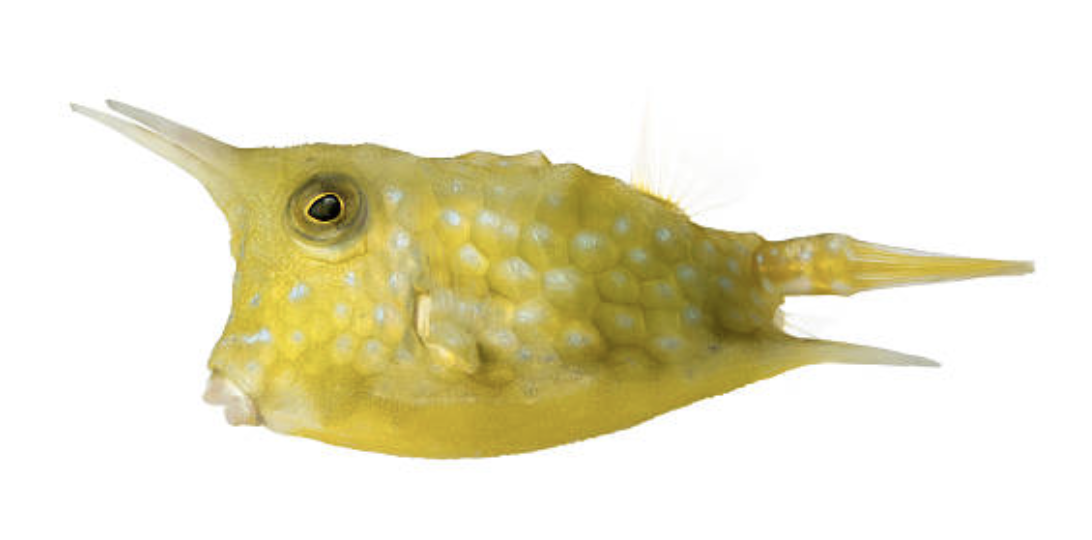
Behavior: slow swimmers. Peaceful. Curious. Grunts when captured.
Defenses: exude deadly toxin, pahutoxin, an ichthyotox poison in mucous secretions of skin. Unique among know fish poisons; toxic to boxfish / mimics sea cucumber toxins in general properties. Horns evolved to make difficult to swallow by predators. If damaged, horns can grow back within a few months. Horns mostly hollow, made of sediment of mineralized collagen
Food: polychaete worms, mollusks, small crustaceans, small fish, benthic algae, various microorganisms, tubeworms, Aquarium-chopped meaty foods & marine algae
Habitat: coral reefs in lagoon, reef flats & protected seaward reefs. 3-148 feet
Humans: don't appear to be poisonous to humans. Pacific considered delicacy, roasted over fire like chestnuts
Life Span: 2-8 years
Poison: in skin/organs. Release when stressed.
Predators: humans, albacore, bigeye tuna
Range: Red Sea & East Africa thru Indonesia to Marquesas, north to south Japan. Tuamotos, S. Korea, north top Ryukyu Islands of S. Japan, south to Australia & Lord Howe Island, off southern Africa in Atlantic. Tropical/subtropical waters.
Size: 4-20 inches
Take a virtual tour of the Untouchable exhibit
An exhibit dedicated to animals that should not be touched and should also not be feared as they are extremely important to ecosystem dynamics.
Here is some information on frequent species exhibited.
Fire Salamander (Salamandra salamandra)
Behavior: shed old skin and eat it. Overheat easily. Hide. Hunt at night. Use rabbit burrows for homes.
Food: slugs, earthworms, grasshoppers, flies, beetles, spiders, centipedes, millipedes
Habitat: fallen logs, under stones in cool damp region
Life Span: 50+ years
Humans: no major threat to humans, as long as toxin not ingested. When handling wear gloves, toxin may cause minor skin irritation
Predators: fish, reptiles, larger amphibians, birds, small mammals-shrews & opossums
Reproduction: internal fertilization. Gestation 2-5 months. Females return to aquatic area, pond or lake, to give birth. After birth, young stay in larval stage in water for 3-5 months til metamorphosis, then become terrestrial adults
Size: .67 oz.
Threats: habitat change or loss from deforestation and pollution
Venom: in rows on sides of head. Can shoot it. Only in adults. Defense against being eaten and microbial attack. Can withstand fire by coating body in venom
Stone Fish

Behavior: world's most venomous fish. Camouflage in surroundings. 13 spines on top w/venom. Venom not used for hunting. Can attack prey in .015 seconds. Spits water. Slow swimmer.
Food: shrimp, fish
Habitat: reef bottoms, near rocks
Humans: venom fatal within 2 hours. Excruciating pain, swelling. Rapidly causes paralysis, tissue necrosis, even heart failure.
Life Span: 5-10 years in wild
Predators: bottom feeding sharks, rays
Range: Indo-Pacific, North Australia
Reproduction: 1 million eggs. Males release sperm on top. Most eggs eaten
Size: 5 lbs. 14-20"
Status: non-threatened
Cone Snail


Behavior: active at night, rely on smell to hunt
1) Proboscis - hunting tool. Venom injected into prey w/harpoon loaded into long thin tube
2) Siphon - similar to a nose, long extendable tube detects prey, directs water to gills to help w/respiration
3) Eye stalks - 2 eyes, either side of mouth. Don't know how well can see, or if enough light in some deeper habitats to make it worthwile
4) Mouth - huge extendable mouth. Extends outwards to engulf prey. Muscle contracts to bring mouth back into shell.
5) Foot - long and muscular, extends to move along surfaces
Habitat: Indian, Pacific, Caribbean & Red Sea, Southern California, Florida, shallow reefs partially buried under sandy sediments, rocks or corals. Bury under sand to hide from prey/predators
Humans: not necessarily fatal, but depending on species, amount of venom injected & victim's size and susceptibility, complete paralysis may occur, which may lead to death. Neurotoxins used to make medicine to treat neuropathic pain.
Life Span: 10-20 years wild and captive
Predators: few. Hermit & horseshoe crabs
Reproduction: eggs fertilized internally by male sperm. Egg capsules contain 500-700 eggs each. Capsules laid under rocks, very few survive. Eggs that survive hatch about 16-17 days. Larvae remain pelagic for about 16 days, then settle onto substrate - about 0.06" long.
Size: ~ 1" - 9"
Status: least concern
Sting: to humans - may not feel pain. Feel numb or stinging.
Fighting Conch (Strombus pugilis)

Behavior: Despite the name, this species is neither aggressive nor dangerous. They use their strong foot to forage for food. If turned upside down, the conch can use that foot as a catapult. Fighting conches have well developed eyes, which gives them better vision than many other snails.
Diet: Detritus, algae and bacteria.
Habitat: Intertidal zones. Marine, alkaline and warm waters. Prefer shallow waters, seagrass beds, coral reefs.
Range: Tropical waters along the eastern coasts of the Americas, from Florida to Brazil.
Life Span: Up to 10 years.
Poison: None
Predators: Hermit crabs
Reproduction: Conch snails are dioecious, with the female having an egg channel in the foot. A male must mate with the female and fertilize the eggs before they are laid. If there is more than one male present, the two males may "fight", using their proboscis. A single nest can contain over 180,000 eggs. They are very small and hatch as free swimming larvae, leaving them vulnerable to be eaten. They metamorphose into juvenile snails after 18 to 24 days.
Size:3-4 inches
Long Spined Sea Urchin (Diodema setosum)

Food: algae from dead corals
Habitat: deeper water near corals. 0-1300 feet
Life Span: 4-8 years in wild, depending on temperature and food
Poison: in spines. Shattering of spine leaves organic material in wound causing intensely painful infections. Poisonous mucous seems to have very little effect on humans.
Predators: queen triggerfish, Caribbean spiny lobsters, Caribbean helmets, 2 species of toadfish
Range: tropical W. Atlantic, Caribbean, Gulf of Mexico, N & E coasts of South America to Brazil, E. Atlantic at Canary Islands
Reproduction: males and females excrete fluid to alert others to respond by releasing eggs/sperm in mass reproduction. More gametes = higher chance of fertilization. Summer/lunar months
Size: body 3-4"D, spines up to 12"
Coral Catfish (Plotosus lineatus) A.K.A. - Striped Eel Catfish

Behavior: Aggressive, hardy scavengers. Best kept in schools.
Diet: Smaller fish and invertebrates, algae, detritus.
Habitat: Coral reefs. Also can be found found in estuaries and tide pools.
Range: Indian Ocean, Western Pacific, East Africa
Venom: Highly venomous spine found in the dorsal and pectoral fins. Can be fatal.
Reproduction: Oviparous, Male digs a nest in demersal area, entices female to lay eggs. Male will guard the eggs.
Size: Up to 12 inches.
Banngai Cardinal Fish (in with long spined sea urchin)

Behavior: semi-aggressive, hide in spine of sea urchins
Food: carnivore, shrimp, bloodworms
Habitat: around jetties, over sandy bottoms w/sea grasses
Life Span: 2 - 4 years
Predators: humans for pet trade
Range: Banngai Archipelago, Indonesia
Reproduction: spawn. male carries in mouth for protection
Size: 3"
Status: Endangered
Threats: Humans
Longhorn Cowfish (Lactoria cornuta)

Behavior: slow swimmers. Peaceful. Curious. Grunts when captured.
Defenses: exude deadly toxin, pahutoxin, an ichthyotox poison in mucous secretions of skin. Unique among know fish poisons; toxic to boxfish / mimics sea cucumber toxins in general properties. Horns evolved to make difficult to swallow by predators. If damaged, horns can grow back within a few months. Horns mostly hollow, made of sediment of mineralized collagen
Food: polychaete worms, mollusks, small crustaceans, small fish, benthic algae, various microorganisms, tubeworms, Aquarium-chopped meaty foods & marine algae
Habitat: coral reefs in lagoon, reef flats & protected seaward reefs. 3-148 feet
Humans: don't appear to be poisonous to humans. Pacific considered delicacy, roasted over fire like chestnuts
Life Span: 2-8 years
Poison: in skin/organs. Release when stressed.
Predators: humans, albacore, bigeye tuna
Range: Red Sea & East Africa thru Indonesia to Marquesas, north to south Japan. Tuamotos, S. Korea, north top Ryukyu Islands of S. Japan, south to Australia & Lord Howe Island, off southern Africa in Atlantic. Tropical/subtropical waters.
Size: 4-20 inches
Take a virtual tour of the Untouchable exhibit
1 point
What is the world's most venemous fish?
1 point
A cone snail injects venom into its prey with which body part?